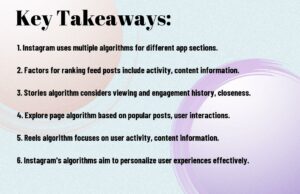Are you tired of feeling like you’re stuck in a never-ending cycle of trial and error on Instagram, wondering why your content isn’t reaching the audience it deserves? **You’re not alone**. With the ever-changing landscape of Instagram’s algorithms, it can be overwhelming to keep up with the latest ranking factors and best practices. But fear not! In this article, we’ll dive deep into the intricacies of Instagram’s algorithms, debunking common myths and providing you with a comprehensive guide on how to make the most of the platform’s various features. From Feed to Stories, Explore, and Reels, **you’ll learn the most important ranking factors** and how to increase your chances of getting your content seen by more people. So, buckle up and get ready to **crack the code** of Instagram’s algorithms and take your content to the next level!
Key Takeaways:
- Multiple Algorithms, Not One: Contrary to popular belief, Instagram does not have a single algorithm that governs all content. Instead, there are multiple algorithms, classifiers, and processes that work together to personalize the user experience.
- Different Algorithms for Different Features: Each feature on Instagram, such as Feed, Stories, Explore, and Reels, has its own algorithm that takes into account unique signals and ranking factors to determine what content to show users.
- Signals and Ranking Factors: Instagram’s algorithms consider a wide range of signals and ranking factors, including user activity, post information, user history, and more, to determine the relevance and value of content to individual users.
- Personalization is Key: Instagram’s algorithms are designed to personalize the user experience, showing users the content that is most likely to interest them, and helping creators and businesses reach their target audiences.
- Quality Over Quantity: Rather than focusing on algorithm hacks or tricks, creators and businesses should focus on producing high-quality content that resonates with their audience, as Instagram’s algorithms reward content that is engaging, relevant, and valuable.

How Instagram Algorithms Work in 2024
Your understanding of how Instagram’s algorithms work is crucial to creating a successful content strategy. Contrary to popular belief, there is no one algorithm to rule them all when it comes to Instagram. In fact, according to a recent update shared by the Meta-owned platform, there are “a variety of algorithms, classifiers, and processes, each with its own purpose” to make sure IG users see the content that most interests them.
Multiple Algorithms, Classifiers, and Processes
For instance, Instagram uses different algorithms to rank content in different parts of the app, such as the Feed, Stories, Explore page, and Reels. Each algorithm has its own set of ranking factors, which are used to predict how likely a user is to interact with a post. These factors, also known as “signals,” can include things like engagement history, information about the post, and information about the person who posted.
Different Parts of Instagram Are Ranked by Different Algorithms
Instagram doesn’t use a single algorithm to rank all types of content. Instead, Reels and the Feed (and Stories and Explore) are all controlled by different algorithms. Why? People’s behavior tends to differ in different areas of the app. “People tend to look for their closest friends in Stories, use Explore to discover new content and creators, and be entertained in Reels,” Head of Instagram Adam Mosseri explains.
Work with this knowledge to your advantage by tailoring your content to each specific part of the app. For example, if you’re looking to increase engagement, focus on creating content that encourages interactions in the Feed. If you’re looking to reach new audiences, focus on creating content that’s likely to appear in the Explore page or Reels.
Be mindful of, understanding how Instagram’s algorithms work is key to creating a successful content strategy. By tailoring your content to each specific part of the app, you can increase engagement, reach new audiences, and ultimately drive more sales.
Ranking Factors in Instagram
Even with the complexity of Instagram’s algorithms, understanding the ranking factors can help you increase your chances of getting your content seen by more people.
The platform takes into account various signals to rank content in different parts of the app, including the Feed, Stories, Explore page, and Reels. Here’s a breakdown of the most important ranking factors in each area:
- Feed Algorithm: Activity, Information about the post, Information about the person who posted, and The user’s history of interacting with someone.
- Stories Algorithm: Viewing history, Engagement history, and Closeness.
- Explore Page Algorithm: Information about the post, A user’s activity in Explore, A user’s interaction history with the poster, and Information about the person who posted.
- Reels Algorithm: A user’s activity, A user’s interaction history with the poster, Information about the Reel, and Information about the person who posted the Reel.
Feed Algorithm
One of the most important signals in the Feed algorithm is activity, which includes posts you’ve liked, shared, saved, or commented on. This helps Instagram understand what type of content you’re interested in and shows you more of it.
Stories Algorithm
Person-to-person interaction plays a significant role in the Stories algorithm. Instagram takes into account how often you view an account’s Stories, engage with them, and your closeness to the author.
Posted Stories are a great way to increase engagement and appear at the top of users’ Feeds. However, it’s imperative to note that Instagram views this area as a space where people tend to look for their closest friends, making it potentially harder for brands to appear in this section.
Explore Page Algorithm
Explore the Explore page, which is designed to help users discover new accounts. Here, information about the post, a user’s activity in Explore, and their interaction history with the poster play a significant role in ranking content.
Engagement is key on the Explore page. If users have engaged with a specific post found via Explore previously, the algorithm will show them more like that. This is why it’s imperative to create high-quality, engaging content that resonates with your audience.
Reels Algorithm
Any content creator or brand can increase their chances of getting their Reels seen by more people by understanding the ranking factors. These include a user’s activity, interaction history with the poster, information about the Reel, and information about the person who posted the Reel.
Poster popularity and engagement also play a role in the Reels algorithm. Instagram considers popularity signals such as the number of followers or level of engagement to help find compelling content from a wide array of people and give everyone a chance to find their audience.
Thou shalt understand the ranking factors to increase thy chances of getting thy content seen by more people on Instagram!

Recommendation Guidelines on Explore and Reels
For a better understanding of how Instagram’s algorithm works, it’s important to familiarize yourself with their Recommendation Guidelines on Explore and Reels. As How the Instagram Algorithm Works (Updated 2024) explains, these guidelines are designed to minimize the chances of recommending content that may be offensive or inappropriate to users.
By understanding these guidelines, you can ensure that your content is more likely to appear on the Explore page and Reels, increasing your visibility and reach.
Minimizing Offensive Content
On Instagram, the goal is to provide a safe and enjoyable experience for all users. To achieve this, they’ve established guidelines to minimize the recommendation of content that may be offensive or inappropriate. Posts that violate these guidelines may not necessarily violate Instagram’s Community Guidelines, but they won’t appear on the Explore page.
Examples of Restricted Content
Reels and Explore pages are designed to showcase entertaining and engaging content. However, some types of content are restricted from appearing on these pages. For instance, content that depicts or discusses self-harm, suicide, eating disorders, or violence won’t be recommended. Similarly, sexually explicit or suggestive content, as well as promotions of certain regulated products like tobacco, are also restricted.
Content that promotes hate speech, discrimination, or harassment towards individuals or groups based on race, ethnicity, religion, or other protected characteristics is also not allowed on the Explore page or Reels.
Bear in mind, Instagram’s algorithms are designed to prioritize content that is engaging, informative, and respectful. By creating content that aligns with these guidelines, you can increase your chances of getting recommended on the Explore page and Reels.

Conclusion
Ultimately, understanding the intricacies of Instagram’s algorithms can seem daunting, but by grasping how each part of the app is ranked and what signals are taken into account, you can increase your chances of getting your content seen by more people. By recognizing that different areas of the app are controlled by different algorithms, you can tailor your content to each specific area, whether it’s Feed, Stories, Explore, or Reels. By doing so, you’ll be well on your way to cracking the code and using Instagram’s algorithms to your advantage.
Here are five FAQs about “Cracking the Code: Understanding the 2024 Instagram Algorithm Changes and How to Use Them to Your Advantage”:
FAQ
Q: What is the main difference between how Instagram ranks content in different parts of the app?
A: The main difference is that each part of the app, such as Feed, Stories, Explore, and Reels, has its own algorithm that takes into account different ranking factors. For example, the Feed algorithm prioritizes activity, information about the post, information about the person who posted, and the user’s history of interacting with someone. On the other hand, the Stories algorithm prioritizes viewing history, engagement history, and closeness.
Q: How does Instagram determine what content to show in the Explore page?
A: Instagram determines what content to show in the Explore page by considering several signals, including information about the post, a user’s activity in Explore, a user’s interaction history with the poster, and information about the person who posted. The algorithm aims to show users content that they are likely to be interested in based on their past activity.
Q: What is the purpose of Instagram’s Recommendation Guidelines?
A: Instagram’s Recommendation Guidelines aim to minimize the chances of recommending content to someone that they may find offensive. The guidelines outline types of content that may not violate Instagram’s Community Guidelines but are still not suitable for recommendation on the Explore page and Reels.
Q: How does Instagram’s algorithm benefit users, creators, and businesses?
A: Instagram’s algorithm benefits users by showing them content that is most relevant and interesting to them. It benefits creators and businesses by providing an opportunity to reach new audiences and increase engagement. By prioritizing content that is likely to engage users, the algorithm helps to reduce noise and increase the overall quality of the user experience.
Q: Are there any specific types of content that perform better on Instagram?
A: While it’s true that certain types of content, such as Reels, may perform better than others, it’s not necessarily because they are given a leg-up by the algorithm. Rather, it’s because they are designed to entertain and engage users in a specific way. By understanding how the algorithm works and creating content that resonates with your audience, you can increase your chances of getting your content seen by more people.





